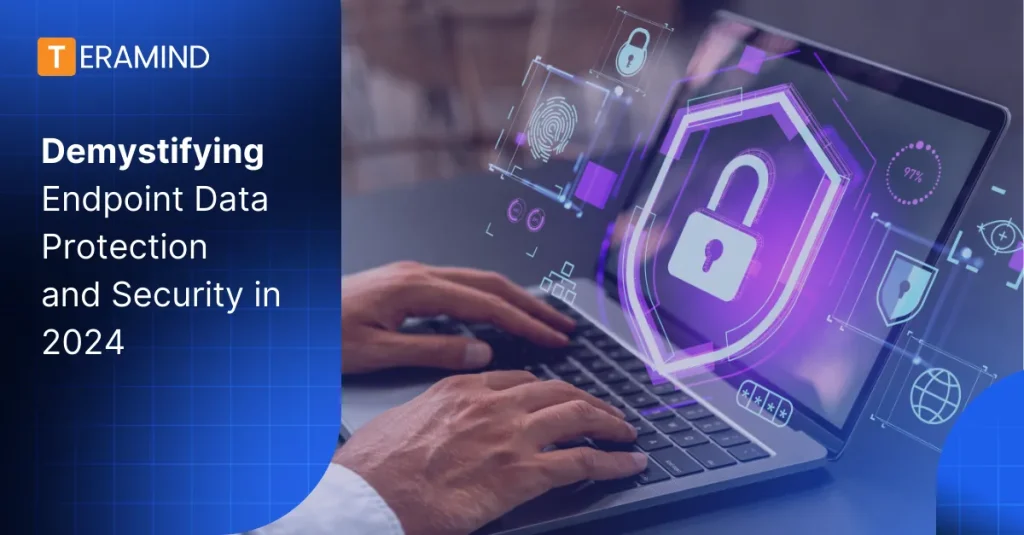Every unprotected endpoint is a potential gateway for cyber threats—are you, as an IT professional, cybersecurity expert, or business professional responsible for data security and network management, paying enough attention to yours? Modern companies deal with hundreds of endpoint devices, from desktops and laptops at the office to employee mobile phones, and protecting them from malicious insider threats and external attackers is getting harder each year. Your role in this is crucial.
Are you confident in your understanding of endpoint data protection? In this guide, we’ll delve into this critical aspect of cybersecurity, exploring its definition, various types and technologies, and sharing some of the best practices you can implement to fortify your endpoint devices.
What is Endpoint Data Protection?
Endpoint Data Protection refers to companies’ techniques, tools, and strategies for securing data stored on endpoint devices such as laptops, desktops, mobile devices, USB devices, and other computing devices connected to the corporate network. The main goal is to prevent data breaches, data loss, and unauthorized access to sensitive information stored on these devices—mainly because they can serve as entry points for malicious attackers.
Types of Endpoint Devices
An endpoint device is any external device that connects to your company network and serves as an access point for user interaction.
Here are the most common examples of endpoint devices in modern organizations:
- Mobile devices: These pocket-sized powerhouses are not just for calls and texts. They’re your on-the-go access to corporate data. But beware, their portability also makes them vulnerable to threats. To fortify your mobile personal devices, consider encryption, mobile device management (MDM) solutions, security apps, and regular OS updates.
- Tablets: Tablets offer larger screens, better processing capabilities, and can handle more data-intensive tasks compared to mobile devices. They’re commonly used for giving presentations, taking notes during meetings, and running more demanding apps.
- Desktops/Laptops: Desktops and laptops are primary workstations in most companies. Due to the valuable data they store, cybercriminals frequently target them. Security measures for these devices include the use of endpoint detection and response (EDR) tools, antivirus software, and multi-factor authentication.
- Servers: Servers are critical infrastructures that store, process, and manage network data and resources. Protecting servers requires advanced security solutions such as network firewalls, intrusion prevention systems, and regular security audits to detect vulnerabilities.
Endpoint Security Technologies
OK – so we’ve covered endpoint data protection and the types of devices it encompasses. Now, let’s check out the specific endpoint security technologies companies use to protect their devices:
Application Control
Application control prevents unauthorized or malicious applications from executing on a network’s endpoints. It allows system administrators to create policies that can block or allow applications based on various criteria, including the app’s publisher, its digital signature, or its behavior patterns.
Application security is particularly important in preventing zero-day attacks, where unknown malware might attempt to infiltrate the system. Application control can stop these unwanted software threats, malware attacks, or any other sophisticated attacks by not allowing unrecognized applications to execute, preventing significant data losses.
Endpoint DLP
Endpoint data loss prevention (DLP) is a security technology that focuses on monitoring, detecting, and blocking sensitive data while in use, in motion, and at rest on endpoints. It helps companies protect against endpoint attacks by ensuring critical information does not leave the network without proper authorization.
Endpoint DLP also has features that identify and categorize sensitive data based on predefined rules and policies, such as financial records, personal information (PII), or intellectual property. It controls how data is transferred through removable storage, cloud service, and other means and enforces the necessary security policies if necessary.
For example, suppose someone tries to copy sensitive data to a USB drive or email it to an unauthorized person. In that case, the endpoint DLP system can stop the transfer and alert the administrators.

User & Entity Behavior Analytics (UEBA)
User and Entity Behavior Analytics (UEBA) is an endpoint security software that uses advanced analytics to identify unusual behavior patterns by monitoring and analyzing the activities of users and entities (such as devices and servers) within a network.
It sets a baseline of normal behavior for each user or entity on the network and monitors the activity on endpoints. By continuously monitoring and analyzing data usage, UEBA can detect deviations from these norms, such as strange login times, excessive requests for sensitive data, or malicious software installations, and quickly recognize internal threats.
These signs can indicate potential insider threats, compromised accounts, or malware infections that conventional security tools might miss. This endpoint solution is beneficial in large, complex settings where it can be hard to distinguish legitimate user activities from potential security threats and spot unauthorized users.
Machine Learning & AI
Machine Learning (ML) and Artificial Intelligence (AI) are revolutionizing endpoint security through automated and sophisticated threat detection and response systems. These systems learn from large datasets to spot patterns that may signal threats, improve, and only get better as they’re exposed to additional amounts of data.
Machine Learning (ML) and Artificial Intelligence (AI) are revolutionizing endpoint security through automated and sophisticated threat detection and response systems. These systems learn from large datasets to spot patterns that may signal threats, improve, and only improve as they’re exposed to additional data.
By automating the detection process and through behavioral analysis, these endpoint security solutions reduce the need for human intervention. This allows for quicker responses to threat actors and significantly lowers the chances of human error, which should give you confidence in your ability to protect your endpoint data.
SIEM
Security Information and Event Management (SIEM) is point protection software that comprehensively overviews a company’s security posture by collecting and analyzing data from various sources across the network (including endpoints). Once it collects the required logs and events, it analyzes them in real-time to look for any potential deviations from normal behavior or unusual lateral movements.
Best Practices for Endpoint Data Security
Want to make sure your endpoint data is impenetrable? Here are the best practices you can follow:
Implement a Comprehensive Endpoint Security Strategy
Start by ensuring that all endpoints are equipped with updated antivirus and anti-malware solutions, firewalls, and intrusion prevention systems to block malicious actors, malware threats, and advanced attacks.
Next, add advanced security solutions such as Endpoint Detection and Response (EDR) and Data Loss Prevention (DLP) tools to monitor, detect, and respond to incidents in real time. These endpoint protection platforms help identify and mitigate threats before they can cause significant damage. By following these best practices, you can be reassured that your endpoint data is well-protected.
Remember to also include regular security training for employees to recognize phishing attempts, other social engineering tactics, and malicious attacks. You’ll need strict access controls and multi-factor authentication to minimize the risk of unauthorized access and prevent data loss.
Regular Monitoring & Endpoint Detection to Mitigate Insider Risk
This practice revolves around continuously observing and analyzing all endpoints’ activities and data traffic, such as workstations, mobile devices, and servers. By doing so, companies can quickly identify unusual or unauthorized activities that could indicate malicious insider actions or data breaches and help mitigate insider risk.
The core of this strategy involves endpoint detection and response (EDR) systems. These systems are designed to provide real-time monitoring and data analysis, using advanced algorithms and machine learning to detect patterns of behavior that deviate from the norm. EDR systems can flag activities such as unauthorized access to sensitive data, unusual login times, or installing unapproved software, potential indicators of insider threats.
Utilize Endpoint Protection Solutions to Defend against Zero-Day & Advanced Threats
You need the right endpoint protection solutions to defend against advanced and zero-day threats that exploit unknown software vulnerabilities before developers have had the chance to issue fixes.
Modern endpoint protection platforms (EPP) include a range of advanced threat detection tools such as machine learning, AI-driven analytics, and behavioral detection technologies. These advanced endpoint security solutions can identify and block zero-day and advanced threats that traditional antivirus solutions might miss.
These solutions are designed to recognize malware and external threat patterns based on behavior rather than relying solely on known signatures. This approach lets them detect essential elements indicating a zero-day exploit, such as unusual network traffic, malicious emails, and suspicious file activities on end-user devices.
FAQs
What is an example of endpoint protection?
A modern endpoint protection platform (EPP) is an example of endpoint protection. EPP solutions utilize advanced threat detection tools like machine learning and AI-driven analytics to identify and block zero-day and advanced threats that traditional antivirus solutions might miss.
What is the difference between endpoint and EDR?
The main difference between endpoint protection and EDR is that endpoint protection focuses on preventing and blocking known threats. At the same time, EDR is more focused on detecting and responding to advanced threats and unusual behavior that may indicate a potential security breach. While endpoint protection aims to provide proactive defense against various types of malware and attacks, EDR systems offer real-time monitoring and analysis of endpoint activities, using advanced algorithms and machine learning to identify patterns of behavior that deviate from the norm.
What is the difference between DLP and endpoint protection?
DLP and endpoint protection serve different purposes. While endpoint protection focuses on defending against external threats and malware, DLP is specifically designed to prevent unauthorized users from leaking or accessing sensitive data. Both solutions are essential components of a comprehensive data security strategy.
What is the primary purpose of endpoint protection?
The primary purpose of endpoint protection is to defend against external threats and malware by utilizing advanced threat detection tools such as machine learning and AI-driven analytics. It focuses on preventing and blocking known threats on end-user devices, providing proactive defense for data security.
Conclusion
Endpoints are often the first line of attack, but with the proper protection strategies, they can also be your strongest defense. Take advantage of the technologies and practices we’ve shared to ensure the security of your corporate endpoints and business data.


